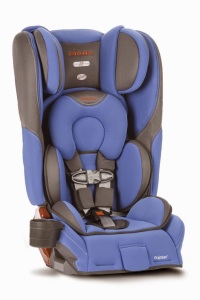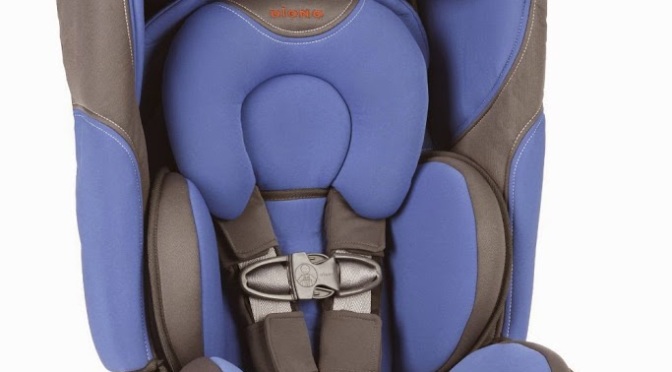 The Diono Rainier and Clek Foonf are two of the four seats with the highest rear-facing limits currently available in the United States (the third and fourth being the Diono Pacifica and Clek Fllo). On the outside, both seats look quite different, even though they have similar goals. Both seats are great, as I’ve discussed in my reviews of the Foonf and the Rainier, but if you’re a new parent, or a parent newly introduced to the wonderful idea of extended rear-facing, you might have a hard time telling the practical difference between the two seats, and why the Foonf is worth around $100 more than the Rainier, depending on which color you’re looking at.
The Diono Rainier and Clek Foonf are two of the four seats with the highest rear-facing limits currently available in the United States (the third and fourth being the Diono Pacifica and Clek Fllo). On the outside, both seats look quite different, even though they have similar goals. Both seats are great, as I’ve discussed in my reviews of the Foonf and the Rainier, but if you’re a new parent, or a parent newly introduced to the wonderful idea of extended rear-facing, you might have a hard time telling the practical difference between the two seats, and why the Foonf is worth around $100 more than the Rainier, depending on which color you’re looking at. Here are my thoughts on the matter, based on my knowledge of both seats and experience with extended rear-facing.
Here are my thoughts on the matter, based on my knowledge of both seats and experience with extended rear-facing.
In short, I do think the extra for the Foonf is worth the difference under certain conditions, but not all. The Foonf anti-reboound bar is designed to give extra protection in side impacts, which are among the most dangerous types of impacts relative to their rate of occurrence in vehicles.
The primary reason for their severity is because cars don’t offer as much protection from the side as they do from the front, which is simply because there’s much less room for protective materials such as high strength steel and crumple zones.
Per Clek, the bar keeps the seat from rotating due to a side impact, which is supposed to help keep the child’s head from being impacted (presumably by the intruding vehicle or crumpling passenger compartment). So what does this all mean for the seats in question?
I would recommend the Foonf over the Rainier under the following conditions:

1.) You believe in Clek’s engineering for side impact protection more than you believe in Diono’s. Both claim to offer enhanced side protection, but Clek goes as far as saying that theirs reduces impact forces by keeping the seat more stable and reducing side to side rotation in the event of a side collision. They also include a crash test video that looks convincing, although it would have been even nicer if they’d included force measurements from the crash test dummy. At any rate, what matters here is whose marketing you believe in more.
2.) You’ve got size constraints in the vehicle in which you’ll be installing your car seat, but don’t want to compromise on 50 lbs of rear-facing goodness. There’s no way around it; the Rainier is a large, large seat. The Foonf, in comparison, is significantly smaller, and can fit in cars that just won’t accept the Rainier without punishing everyone sitting in the front seats.
3.) You have another seat already set up for the 5-13 lb range and don’t need a seat that you can use right from the hospital / birthing center (because remember, you can’t put a newborn in the Foonf unless s/he’s heavy enough to be on the nightly news). If you buy the Foonf, it’s guaranteed that it won’t be your only seat, and that it won’t be the first seat your child sits in.
Note: Using the Clek Infant-thingy infant insert reduces the rear-facing weight limit to 5 pounds and overrides the need for your infant to be able to sit upright without assistance. In other words, it completely negates this advantage of the Rainier over the Foonf / Fllo.
4.) You aren’t interested in harnessed front-facing until the cows come home, or until you hit the 90 lb limit of the Rainier, and think 65 lbs is good enough. The research suggests that properly seated and restrained children in boosters are as safe as equivalent forward-facing harnessed children, but that refers to children who are seated properly 100% of the time.
5.) You want a seat that looks as good as it’s engineered, or are interested in one of the many psychedelic patterns available on the Foonf that just aren’t in the Diono range. Aesthetics may not matter to some folks, but they do matter to others, so don’t dismiss this out of hand.
6.) You have the extra $100 or so. This is perhaps the condition that will make the most difference at first glance for many parents, but try not to make your decision entirely on it, as I honestly believe the other conditions are more important (except for perhaps #5).
7.) You have an extraordinarily long-torsoed child. The Foonf might theoretically give you a bit more time by height than the Rainier, because even though it has a slightly shorter height limit (43″ vs 44″), it has a slightly higher shell measurement when rear-facing (26.5″ vs 25″), which means that a child has slightly more room to grow in the torso when in a Foonf than in a Rainier. However, children who are more proportional might not last any longer in one than the other, so this is really a case-by-case difference.
If you can satisfy most of those seven conditions, then the Foonf is for you. Keep in mind that some of those points are non-negotiable; specifically, the lower and higher weight limits are factual differences between the seats, as is the price, while the other elements are more up for debate. If all of this sounds too complicated, then the Rainier will also keep your child safe. Remember that at this level, your driving abilities will make much more of a difference than which of these two seats you choose. You can buy the Foonf here and the Rainier here.
—
If you find the information on car safety, recommended car seats, and car seat reviews on this car seat blog helpful, you can shop through this Amazon link for any purchases, car seat-related or not. Canadians can shop through this link for Canadian purchases.

